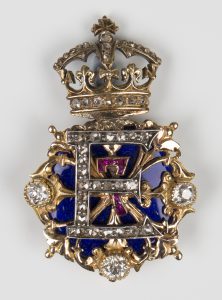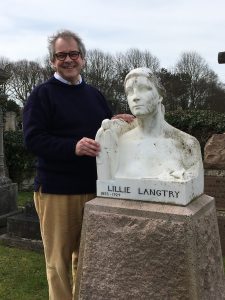
This week I am returning to the Parish of St Saviour on the Island of Jersey.
The church has a particular place in my heart as it was here that I was blessed to marry Teresa a little more than twenty-five years ago.
Today, though, my visit has been inspired by a jewel that was discovered and sold recently by Toovey’s. This gold, diamond, ruby and enamelled brooch in the form of the King’s Royal Cypher is set with rose cut diamonds, designed as a crown above the initial ‘E’ and a ruby set number ‘7’ against a blue enamelled ground. It was accompanied by a note from Lillie Langtry’s granddaughter, Mary Malcolm, in which she writes ‘this jewellery was given to my Grandmother Lillie Langtry in 1879 by Edward VII (she was his mistress)’.
Lillie Langtry, née Le Breton, (1853-1929) was the youngest child of the Dean of Jersey, The Very Reverend William Corbet Le Breton.
Lillie met her husband Edward Langtry, a wealthy widower, at the wedding of her brother. They were engaged and six weeks later they married at St Saviour’s Church on the 9th March 1874.
During her first season in London she was acclaimed as a great beauty. Her beauty and character was captured in portraits by artists including Millais, Watts, Whistler and Burne-Jones, Oscar Wilde even published a poem about her. It was this same beauty which drew the attention of a series of wealthy admirers and lovers as the years went by, including the Prince of Wales, later Edward VII.
The Prince of Wales had arranged to be seated next to Lillie Langtry at a dinner party given by Sir Allen Young in the May of 1877. As his infatuation with her grew Lillie became his mistress and she was even presented to his mother, Queen Victoria. The affair lasted until 1880 and the diamond and ruby encrusted brooch would have been given during this time. They remained friends even after the affair had ended.
Lillie Langtry turned to acting touring Britain and the United States filling theatres and attracting huge crowds. The scale of her fame is difficult to imagine even in our own age of mass media and celebrity.
She bred racehorses in America and Britain which connected her with high society on both sides of the Atlantic.
In 1918 Lillie Langtry retired from the stage and built a villa at Monte Carlo where she lived until her death in 1929. In America she had been known as the Jersey Lily and in accordance with her wishes her body was returned to the island of her birth and she was buried at St Saviour’s. As you can see her grave is marked by a carved marble bust portrait by J Galle.

As an antiquarian it delights me that objects give us a window onto the past and it seems fitting that this small brooch is returning to Jersey too where it will be on display at the Jersey Museum in St Helier with a number of items left to it by Lillie Langtry herself.
By Rupert Toovey, a senior director of Toovey’s, the leading fine art auction house in West Sussex, based on the A24 at Washington. Originally published in the West Sussex Gazette.